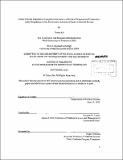| dc.contributor.advisor | Richard M. Locke. | en_US |
| dc.contributor.author | Pal, Timea | en_US |
| dc.contributor.other | Massachusetts Institute of Technology. Department of Political Science. | en_US |
| dc.coverage.spatial | ee----- ec----- | en_US |
| dc.date.accessioned | 2014-02-10T16:54:20Z | |
| dc.date.available | 2014-02-10T16:54:20Z | |
| dc.date.issued | 2013 | en_US |
| dc.identifier.uri | http://hdl.handle.net/1721.1/84850 | |
| dc.description | Thesis (Ph. D.)--Massachusetts Institute of Technology, Dept. of Political Science, 2013. | en_US |
| dc.description | "September 2013." Cataloged from PDF version of thesis. | en_US |
| dc.description | Includes bibliographical references (pages 262-284). | en_US |
| dc.description.abstract | The central argument of my dissertation is that national labor relation institutions where transnational private regulatory efforts are implemented influence the extent and manner of public-private regulatory complementarities. The analytical framework I use to examine the processes of regulatory complementarities is informed by the political economy of gradual change in the comparative institutionalism literature. The labor relation institutions of particular relevance include tripartite and industrial relation institutions, as well as political affiliations between state and workers' organizations, although to a more limited extent. On one hand, these institutions influence the incentives for domestic unions to use transnational private regulatory efforts in strategic manners to promote regulatory improvements. On other hand, they shape the ability of domestic unions and transnational actors to use state regulation as a source of legitimacy for their demands for improvements. I further argue that these favorable conditions are more common in national contexts with market oriented, rather than state-directed and coordinated labor relation institutions. I use the electronics sector from Hungary, Romania and Slovenia during the 2000s as the empirical window to examine divergent pathways of regulatory interactions. The empirical analysis illustrates that while labor relation institutions facilitated the emergence of regulatory complementarities in the market-oriented institutional context of Hungary, these institutions were less favorable to similar developments in the state-directed context of Romania and coordinated institutional setting of Slovenia. Additionally, the implementation style of transnational private regulation set opportunities for two types of regulatory developments: union and compliance driven regulatory complementarities. An additional essential claim of the dissertation is that instead of approaching public-private regulatory complementarities as functional synergies that emerge automatically, to rather understand them as political processes that are closely connected to national institutions. Finally, regulatory complementarities are more likely to emerge around labor concerns that are prevalent and politically salient in a national context. | en_US |
| dc.description.statementofresponsibility | by Timea Pal. | en_US |
| dc.format.extent | 284 pages | en_US |
| dc.language.iso | eng | en_US |
| dc.publisher | Massachusetts Institute of Technology | en_US |
| dc.rights | M.I.T. theses are protected by
copyright. They may be viewed from this source for any purpose, but
reproduction or distribution in any format is prohibited without written
permission. See provided URL for inquiries about permission. | en_US |
| dc.rights.uri | http://dspace.mit.edu/handle/1721.1/7582 | en_US |
| dc.subject | Political Science. | en_US |
| dc.title | Public-private regulatory complementarities in a world of fragmented production : labor regulation in the electronics industry of Eastern Central Europe | en_US |
| dc.title.alternative | Labor regulation in the electronics industry of Eastern Central Europe | en_US |
| dc.type | Thesis | en_US |
| dc.description.degree | Ph.D. | en_US |
| dc.contributor.department | Massachusetts Institute of Technology. Department of Political Science | |
| dc.identifier.oclc | 868231795 | en_US |
